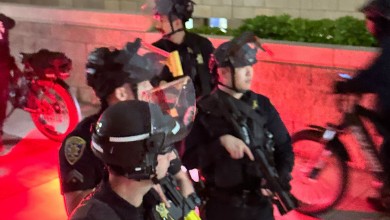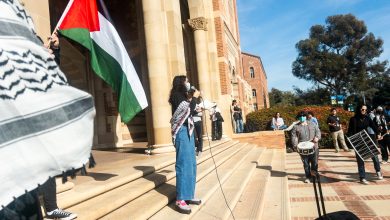The Butterfly Effect: Artists Are Here to Disturb the Peace

Design by Margaret Jackson
On Feb. 6, 2019, Favianna Rodriguez discussed the power of art in social activism and shared her unique life stories in an event called “The Butterfly Effect — Activism and Transformation Through the Arts” at Glorya Kaufman Hall.
The event was presented by the UCLA Visual and Performing Arts Education (VAPAE) Program, in collaboration with the UCLA Department of World Arts and Cultures/Dance, UCLA Graduate School of Education and Information Studies, UCLA Art and Global Health Center, UCLA Center for Community Schooling, and the Fowler Museum at UCLA. The night was divided into three parts: a lecture presented by Favianna Rodriguez, a panel by her and guests, and a following Q&A session.
According to Favianna Rodriguez, the chances that have made her the successful artist she is today are one in a thousand. Despite how talented she was as a kid, the environment she grew up in spared her no direct pathway to make it as a artist. “Every single step I take forward, there are 100 kids who are left behind.”
Favianna Rodriguez was born in an immigrant family in Oakland. The community she lived in was at times struggling with poverty, gangsters, and drugs that became part of her childhood experience. To escape the pain she felt in life, she turned to art.
Nonetheless, growing up it seemed that pursuing art was never meant to be her path. Being a first generation American and college student in the household, she carried her parents’ expectations to become a doctor or a lawyer, and to be good at math and sciences at school. Meanwhile, her image was never represented in the arts world. Among the pictures of phenomenal artists, all she could see were pictures of Picasso, Monet, Rembrandt, etc. —no one but white males.
Rodriguez was compelled to believe only men with white skin could grow up to be artists because those exclusively white and male images were the norm during her childhood years. However, she believes it is still the norm today. Three decades have since passed, and the featured pieces in museums are still overwhelmingly (75 percent) white and male.
As time went by, Rodriguez began to realize the people who shape culture are those with power. In her youth, she witnessed the anti-immigrant movement forming in California. Following the California Proposition 187 in 1994, commercials promoting anti-immigration sentiment sprung up, which often featured white men running on borders, accusing immigrants of job stealing, of murdering, and of raping.
It took only one look at her mother to prove the commercial wrong. At that time, her mother had three jobs and she worked from dawn to well past dusk, exemplifying the exact opposite of the perception of immigrants stealing jobs and exploiting the welfare system. She then came to the conclusion that politics was never about being logical or rational. It is about who tells the most compelling story. And the story doesn’t have to come from the authority — often times it comes from the art.
Art can disrupt the existing narratives. Policies are manifestations of ideas, and ideas originate from culture. Culture is composed of any industry that is involved in the creation of myths and stories, such as theater, TV, social media, etc. — all forms of arts that we immerse ourselves into and are influenced by everyday.
The power of art outlasts policies. It wasn’t until 18 years after Ellen DeGeneres came out on TV that the same-sex marriage law passed. Similarly, even though no law has yet emerged from the Me Too movement, the social discourse about sexual assault has shifted enormously through people sharing stories and supporting each other on social media.
In fact, even without the corresponding support from politics, a single idea can wield influence that lasts for decades. California Proposition 187 started the anti-immigration movement which has lasted over 20 years. Around the same time, President Clinton decided to militarize the American border shortly after he opened the border for multinational corporations. The two events jointly introduced the metaphor of a wall — associating immigrants with danger and treating them with exclusion — to American’s imagination. Despite many concrete evidences that walls are ineffective to secure the border, the American culture continues to nourish the concept of the wall to the extent of embodying it as a policy today.
Because art creates worlds without boundaries, it can open people’s minds simply by showing an alternative world. For example, in response to the policy of building a wall, the Hammer Museum put on a show titled “Art Without Walls,” encouraging people to reflect on the effect this policy can bring. Art can also lead to making lasting difference. Today, whenever we see a pink triangle we know it’s a safe space for the LGBTQ+ community.
Rodriguez believes that art allows one to tell one’s own story, which is crucial for combating the anti-immigration movement. Bringing in her personal narratives contributes to the positive representation of immigrants, and through telling her stories as an artist on social media, she helps the next generation to see more possibility in themselves.
Although during her youth, her ambition to become an artist was almost deterred by her immigrant background with a relatively low socioeconomic position and strict parenting, Rodriguez never stopped pursuing art. She participated in art community classes as the only non-adult student before college. However, when she finally gained enough academic freedom to pursue art in college, she was turned down by the university department of art due to her lack of art education background — she hadn’t known what a portfolio was.
Fortunately, she later encountered a professor that introduced her to an art organization in Los Angeles, which exposed her to art for the first time, and led her to more artistic opportunities. In retrospect, Rodriguez concluded that even as a talented kid, poverty and being a racial minority spared no direct pathway for her artistry. “The chance for me to meet those folks [who introduced her to the art world] was one in a thousand. If it wasn’t for those adults who intervened, I would have not done it. This was all chance.”
Unfortunately, recent data collection tells the same story about how impossible it is for a kid like Rodriguez to make it in the art world. Rural populations make up 20 percent of the total population but only receive less than 2 percent of the arts foundations funding to communities. Low-income areas makes up 50 percent of the population and receive 2 percent of the funding. People of color, equivalent to 37 percent of the population, receive only 4 percent of the funding.
We are living in a culture that does not nurture the arts or art education for people of color. The economy exploits artists in general to the point that they make on average $19 per hour. As a consequence, minorities with no economic foundation withdraw from pursuing an education in arts, which leads to continued under-representation in art scenes, and in leading the social discourse.
It is therefore only the combination of culture, economics, and politics that can ultimately facilitate lasting social change.
To conclude the lecture, Rodriguez pointed out that now is the pivotal moment for social change, with social media advancing at an unprecedented rate, the gap between the rich and the poor widening day by day. The unfair ecosystem of opportunities makes people of color carry the burden of its consequence, and as a result seems to make it their jobs alone to fix the system. She encouraged the audience to consume more kinds of art to support artists across the spectrum, and support artists from unconventional backgrounds.




